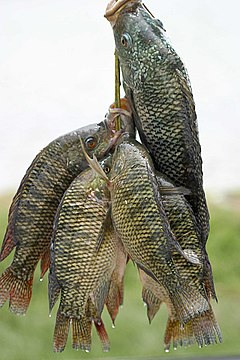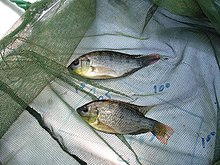Tilapia: Difference between revisions
| Line 40: | Line 40: | ||
==Noxious pest== |
==Noxious pest== |
||
{{main|Tilapia as exotic species}} |
{{main|Tilapia as exotic species}} |
||
[[Image:Jensens Crossing fish survey Dec07 012.jpg|thumb|220px|Electro-fishing survey for Tilapia in [[Endeavour River]]]] |
[[Image:Jensens Crossing fish survey Dec07 012.jpg|thumb|220px|[[Electrofishing|Electro-fishing]] survey for Tilapia in [[Endeavour River]]]] |
||
[[Image:Jensens Crossing fish survey Dec07 029.jpg|thumb|220px|Immature Mozambique tilapia, ''[[Oreochromis mossambicus]]'', caught in Endeavour River, Dec. 2007.]] |
[[Image:Jensens Crossing fish survey Dec07 029.jpg|thumb|220px|Immature Mozambique tilapia, ''[[Oreochromis mossambicus]]'', caught in Endeavour River, Dec. 2007.]] |
||
Impacts on [[Australia]]n rivers, creeks and ponds have been great, particularly the dramatic decreases in native fish populations due to predation and competition for food by the fast breeding tilapia that consume a vast range of food sources <ref name="McDonald_2005">{{cite web | last=McDonald | first=Ian | title =Press Release - Tilapia under attack | publisher=Ian McDonald Federal Minister for Fisheries and Conservation at the time | date =2005-07-21 | url=http://www.mffc.gov.au/releases/2005/05141m.html | accessdate=2007-03-01 }}</ref>. Further habitat impacts include increases in local turbidity levels from nesting behaviours and native fish, invertebrates, and other organisms experience reduced access to cover through the aggressive territorial defense of breeding and feeding sites by some tilapia species. |
Impacts on [[Australia]]n rivers, creeks and ponds have been great, particularly the dramatic decreases in native fish populations due to predation and competition for food by the fast breeding tilapia that consume a vast range of food sources <ref name="McDonald_2005">{{cite web | last=McDonald | first=Ian | title =Press Release - Tilapia under attack | publisher=Ian McDonald Federal Minister for Fisheries and Conservation at the time | date =2005-07-21 | url=http://www.mffc.gov.au/releases/2005/05141m.html | accessdate=2007-03-01 }}</ref>. Further habitat impacts include increases in local turbidity levels from nesting behaviours and native fish, invertebrates, and other organisms experience reduced access to cover through the aggressive territorial defense of breeding and feeding sites by some tilapia species. |
||
Revision as of 00:28, 13 March 2008
| Tilapiine cichlids | |
|---|---|

| |
| Nile tilapia (Oreochromis niloticus niloticus) | |
| Scientific classification | |
| Kingdom: | |
| Phylum: | |
| Class: | |
| Order: | |
| Family: | |
| Subfamily: | |
| Tribe: | |
| Genera | |
|
Oreochromis (about 30 species) | |
Tilapia (Template:PronEng) is the common name for nearly a hundred species of cichlid fishes from the tilapiine cichlid tribe. Tilapias inhabit a variety of fresh and, less commonly, brackish water habitats from shallow streams and ponds through to rivers, lakes, and estuaries. Most tilapias are omnivorous with a preference for soft aquatic vegetation and detritus. They have historically been of major importance in artisanal fishing in Africa and the Levant, and are of increasing importance in aquaculture around the world (see tilapia in aquaculture). Where tilapia have been deliberately or accidentally introduced, they have frequently become problematic invasive species (see tilapia as exotic species).
Etymology
The common name tilapia is based on the name of the cichlid genus Tilapia, which is itself a latinisation of thiape, the Tswana word for "fish".[1] The genus name and term was first introduced by Scottish zoologist Andrew Smith in 1840.[2]
As they have been introduced globally for human consumption, tilapia often have specific names for them in various languages and dialects. Certain species of tilapia are sometimes called "St. Peter's fish." This term is taken from the account in the Christian Bible about the apostle Peter catching a fish that carried a shekel coin in its mouth. According to the tale, the dark spots on the sides of the fish, a common pattern in many tilapiine cichlids, are the fingermarks of the saint.[3] While that name is also applied to Zeus faber, a marine fish not found in the area, one tilapia (Sarotherodon galilaeus galilaeus) is known to be found in Sea of Galilee where the account took place. This particular species is known to have been the target of small-scale artisanal fisheries in the area for thousands of years.[4][5] In some Asian countries including the Philippines, large tilapia are often referred to as pla-pla while their smaller brethren are still referred to as tilapia.[6]In Hebrew, tilapia are called amnon (אמנון). In Arabic, tilapia are called bolty (بلطي ).[citation needed]
Introduced as a biological control
Tilapia have been used as biological controls for certain aquatic plant problems. They prefer a floating aquatic plant, duckweed (Lemna sp.) but also consume some filamentous alga [3]. In Kenya tilapia were introduced to control mosquitoes which were causing malaria. They consume mosquito larvae, consequently reducing the numbers of adult female mosquitoes, the vector of the disease (Petr 2000). These benefits are, however, frequently outweighed by the negative aspects of tilapia as invasive species (see tilapia as exotic species). In Kenya the Tilapia found in Lake Victoria (Sango), is referred to as Ngege by the Luo. Its export to the European market has threatened this delicacy's availability to the Luos who consider it a staple food.
Aquaria
The larger tilapias are generally not viewed as good community aquarium fish because they eat plants and tend to be very disruptive, digging up the substrate and fighting with other fish. The smaller west African species, such as Tilapia joka, and those species from the crater lakes of Cameroon are, by contrast, relatively popular. Conversely, in cichlid aquariums tilapias can be mixed well with non-territorial cichlids, armoured catfish, tinfoil barbs, garpike, and other robust but peaceful fish. Some species, including Tilapia buttikoferi, Tilapia rendalli, Tilapia joka, and the brackish-water Sarotherodon melanotheron melanotheron, are attractively patterned and decorative fish.
Aquaculture
Tilapia has become the third most important fish in aquaculture after carps and salmonids, with production reaching 1,505,804 metric tons in 2002[7].
Noxious pest


Impacts on Australian rivers, creeks and ponds have been great, particularly the dramatic decreases in native fish populations due to predation and competition for food by the fast breeding tilapia that consume a vast range of food sources [8]. Further habitat impacts include increases in local turbidity levels from nesting behaviours and native fish, invertebrates, and other organisms experience reduced access to cover through the aggressive territorial defense of breeding and feeding sites by some tilapia species.
Tilapia are listed as a noxious pest in Queensland, Australia,[9] and are spreading rapidly into previously untouched and relatively pristine river systems such as the Endeavour River near Cooktown,[10] and in dams on nearby properties. Tilapia are particularly difficult to eradicate.[11]
As tilapia can thrive in fresh, brackish and salt water,[12] it is thought that infestation in one river can lead to infestation of neighbouring rivers by the fish swimming from the mouth of one to the other through the sea. Although they can be successfully farmed as a food fish, in the wild they tend to breed in large numbers and not grow large enough to be of commercial size.
Philippines
On January 11, 2008, the Cagayan Bureau of Fisheries and Aquatic Resources (BFAR) stated that tilapia production grew and Cagayan Valley is now the Philippines’ tilapia capital. Production supply grew 37.25% since 2003, with 14,000 metric tons (MT) in 2007. The recent aquaculture congress found that the growth of tilapia production was due to government interventions: provision of fast-growing species, accreditation of private hatcheries to ensure supply of quality fingerlings, establishment of demonstration farms, providing free fingerlings to newly constructed fishponds, and the dissemination of tilapia to Nueva Vizcaya (in Diadi town). Former cycling champion Lupo Alava is a multi-awarded tilapia raiser in Bagabag, Nueva Vizcaya. Chairman Thompson Lantion of the Land Transportation Franchising and Regulatory Board, a retired two-star police general, has fishponds in La Torre, Bayombong, Nueva Vizcaya. Also, Nueva Vizcaya Gov. Luisa Lloren Cuaresma also entered into similar aquaculture endeavors in addition to tilapia production.[13]
References
- ^ Chapman, Frank A. (July 1992). "Culture of Hybrid Tilapia: A Reference Profile" (html). Circular 1051. University of Florida, Institute of Food and Agricultural Sciences. Retrieved 2007-08-17.
- ^ "Genera Summary: Tilapia" (html). Catalog of Fishes - W.N. Eschmeyer; California Academy of Sciences. FishBase. June 2007. Retrieved 2007-08-17.
- ^ Matthew 17:24−27
- ^ Baker, Jenny (1988). Simply Fish. London: Faber & Faber. pp. 197 pp.
- ^ Rosencrans, Joyce (2003-07-16). "Tilapia is a farmed fish of biblical fame". The Cincinnati Post. E. W. Scripps Company. Archived from the original on 2006-02-18. Retrieved 2007-08-25.
{{cite news}}: More than one of|author=and|last=specified (help) - ^ FAO Fishery Information, Data and Statistics Service (1993). "Aquaculture production (1985-1991)". FAO Fisheries Circular. 815. FAO: 20–21.
- ^ Fessehaye, Yonas (2006). Natural mating in Nile tilapia (Oreochromis niloticus L.) Implications for reproductive success, inbreeding and cannibalism (PDF). Wageningen: Wageningen UR. pp. 150 pp. ISBN 90-8504-540-1.
- ^ McDonald, Ian (2005-07-21). "Press Release - Tilapia under attack". Ian McDonald Federal Minister for Fisheries and Conservation at the time. Retrieved 2007-03-01.
- ^ "Exotic pest fish - commonly asked questions and answers." [1]
- ^ "Tilapia shock: Noxious fish placed in the Endeavour River deliberately." Sarah Martin. Cooktown Local News. January 9, 2008, p. 1.
- ^ "Double dose of poison fails to wipe out tilapia." Sarah Martin. Cooktown Local News. February 6, 2008, pp. 1, 3.
- ^ "Aquaponics" [2]
- ^ Abs-Cbn Interactive, Cagayan Valley country’s tilapia capital
Bibliography
- FAO Fishery Information, Data and Statistics Service (1993). "Aquaculture production (1985-1991)". FAO Fisheries Circular. 815. FAO: 20–21.
- Petr, T. (2000): Interactions between fish and aquatic macrophytes in inland waters. A review. FAO Fisheries Technical Papers 396.
- Trewavas, Ethelwynn (1983): Tilapiine fishes of the genera Sarotherodon, Oreochromis and Danakilia. Published by the British Museum (Natural History), London. 583 pages. ISBN 0-565-00878-1
See also
External links
- Tilapia project at Australian Centre for Tropical Freshwater Research, James Cook University [4]
- Information on two tilapia pest species from the Australian Centre for Tropical Freshwater Research as PDF downloads: [5]
